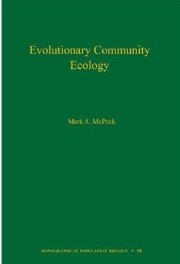Evolutionary Community Ecology
 Mark A McPeek
Mark A McPeek
Princeton University Press, £49.95
The author sets out by asking "why do these species live here but not over there, and why do those species live over there and not here?"
From here, McPeek develops his argument on patterns of species distribution and abundance in locality, time and space, and the other fundamental questions that help understand the ecological processes that maintain these patterns both today and into the future. He describes an imaginary experiment in which he travels back 10 million years to view the types of ponds and lakes the various taxa of eastern North America inhabit, and then views their development and that of their descendants to the present day.
Which evolutionary paths the species take depends largely on the daily ecological interactions experienced by them across the landscape and the ways in which the individual species change in order to fully exploit these experiences – thus determining over time their eventual distribution, abundance and diversity. In arriving at this point McPeek acknowledges the use of the two great metaphors of Stephen J Gould (1989) and G Evelyn Hutchinson (1965).
From this point onwards, there follows the possible consequences of whether a species can exploit an ecological opportunity or not, and how such an outcome might affect the organisation of the local community, the evolutionary path taken by the taxa and the structure of the regional biota.
I found the ideas thoroughly absorbing and enjoyed reading the remainder of the book despite finding the mathematical detail hard going. Clearly, I'm not a specialist, but I learned much from the non-mathematical discourse and I'm very sure that for those readers who are experts, the seven chapters and extensive bibliography will represent excellent value despite the book's high price tag.
Dr Stephen Hoskins CBiol FRSB


